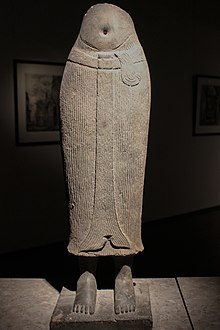|
Sampot
 A sampot (Khmer: សំពត់ /sɑmpʊət/ Khmer pronunciation: [sɑmpɔt]),[1] a long, rectangular cloth worn around the lower body, is a traditional dress in Cambodia.[2] It can be draped and folded in several different ways. The traditional dress is similar to the dhoti of Southern Asia. It is also worn in the neighboring countries of Laos and Thailand where it is known as pha nung (Thai: ผ้านุ่ง [pʰâː nûŋ]).[3] OriginsThe sampot dates back to the Funan era when a Cambodian king ordered the people of his kingdom to wear the sampot at the request of Chinese envoys.[4] It is similar to the lungi and dhoti worn in the Indian subcontinent, the longyi worn in Burma, and the sarong worn in maritime Southeast Asia. Silk weaving was an important part of Cambodia's cultural past. People from Takéo Province have woven silk since the Funan era and records, bas-reliefs, and Zhou Daguan's report have shown that looms were used to weave sompots since ancient times.[4] Complex methods and intricate patterns have been developed to make the cloth, one of which is the hol method which involves dyeing patterns on silk before weaving. What remains unique to Cambodian weavers is the uneven twill technique. The reason they adopted such an unusual method remains unclear.[5] However, little is known about the Old Khmer vocabulary for these fabrics, and if the sampot today was simply changed over time from the original Angkorian textiles. The ancient bas-reliefs however provide a complete look at what fabrics were like, down to patterns and pleats. Silk woven cloths are used in weddings and funerals and for decoration of temples.[6] In Angkor Empire (1955) by George Benjamin Walker, recorded the origin of the modern sampot, which was compiled from these historian authorities: R. C. Majumdar, Reginald Le May, Kalidas Nag, Horace Geoffrey Quaritch Wales, George Charles Brodrick, Lawrence Palmer Briggs, Cedric Dover, and French scholars of the French School of the Far East:
In the run-up to the 1993 Cambodian general election, Khmer leader Son Sann in a heated debate called for a sampot test to be used to establish whether or not women could vote or not in the election; walking a few yards in a tight sampot would be a sign of true Khmer identity, in contrast with the Vietnamese women who would usually wear pants under the ao dai.[8]
TextilesThere are three important silk textiles in Cambodia. They include the ikat silks (chong kiet in Khmer), or hol, the twill-patterned silks and the weft ikat textiles.[citation needed] Patterns are made by tying natural and synthetic fibers on the weft threads and then it is dyed. It is repeated for different colors until the patterns firm and cloth is woven.[citation needed] Traditionally, five colors are used, predominantly red, yellow, green, blue and black.[citation needed] The Sompot Hol is used as a lower garment and as the sompot chang kben. The Pidan Hol is used as a ceremonial hanging used for religious purposes. VariationsSampot Phamuong Sampot Hol There are many variations of the sampot; each is worn according to class. The typical regular sampot, known also as the sarong is typically worn by men and women of lower class. It measures approximately one and a half meters and both ends are sewn together. It is tied to secure it on the waist.[citation needed]
In daily lifeThe sompot is deeply rooted in Cambodia. Even though the French brought a degree of Westernization to Cambodia, Cambodians continued to wear the sompot. Royalty and government officials used the sampot chang kben with a formal jacket. The sompot chong kben and sompot phamuong are still worn by Cambodians today during special occasions, and rural and poor Khmers still prefer it over Western-style clothing for its comfort. The material used by poor and rural Cambodians is not hand-woven silk but printed batik-patterned cloth imported from Indonesia. It is still popular with both men and women alike and is regarded by the people of Cambodia as their national garment.[citation needed] See also
Further reading
References
External linksWikimedia Commons has media related to Sampot. |




